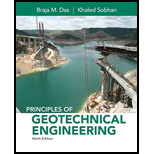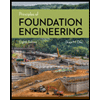
Principles of Geotechnical Engineering (MindTap Course List)
9th Edition
ISBN: 9781305970939
Author: Braja M. Das, Khaled Sobhan
Publisher: Cengage Learning
expand_more
expand_more
format_list_bulleted
Concept explainers
Question
Chapter 13, Problem 13.23P
(a)
To determine
Draw the variation of Rankine’s active pressure on the wall with depth.
(b)
To determine
Find the depth
(c)
To determine
Find the total active force
(d)
To determine
Find the total active force
Expert Solution & Answer
Trending nowThis is a popular solution!

Students have asked these similar questions
A retaining wall 6 m high with a vertical back face retains a homogeneous saturated soft clay. The saturated unit weight of the clay is 19.8 kN/m^3. Laboratory tests showed that the undrained shear strength, cu, of the clay is 14.7 kN/m^2.
a. Do the necessary calculations and draw the variation of Rankine’s active
pressure on the wall with depth.
b. Find the depth up to which a tensile crack can occur.
c. Determine the total active force per unit length of the wall before the tensile crack occurs.
d. Determine the total active force per unit length of the wall after the tensile crack occurs. Also find the location of the resultant.
3. A 15 ft high retaining wall with vertical back face retains a homogeneous saturated soft clay. The
saturated unit weight of the clay is 122 Ib/ft³. Laboratory tests showed that the undrained shear
strength, cu,
of the clay is equal 350 lb/ft?. 0=0.
a. Find the depth up to which the tensile crack can occur.
b. Determine the total active force per unit length of the wall before the tensile crack occurs.
C.
Determine the total active force per unit length of the wall after the tensile crack occurs.
Considering that the horizontal thrust from the back of a 5.5 m wide brick wall to the 1 m deep part of the wall is H = 55 kN
a) Find the greatest stress in the base when b = 2 m.b) Find the width b so that there is a shrinkage zone at the base.(Note: unit weight of brick wall ỿ = 24 kN / m3 )
Answer: ϭmax=0,30 Mpa, b=2,23 m
Chapter 13 Solutions
Principles of Geotechnical Engineering (MindTap Course List)
Ch. 13 - Prob. 13.1PCh. 13 - Prob. 13.2PCh. 13 - Prob. 13.3PCh. 13 - Prob. 13.4PCh. 13 - Prob. 13.5PCh. 13 - Prob. 13.6PCh. 13 - Prob. 13.7PCh. 13 - Prob. 13.8PCh. 13 - Prob. 13.9PCh. 13 - Prob. 13.10P
Ch. 13 - Prob. 13.11PCh. 13 - Prob. 13.12PCh. 13 - Prob. 13.13PCh. 13 - Prob. 13.14PCh. 13 - Prob. 13.15PCh. 13 - Prob. 13.16PCh. 13 - Prob. 13.17PCh. 13 - Prob. 13.18PCh. 13 - Prob. 13.19PCh. 13 - Prob. 13.20PCh. 13 - Prob. 13.21PCh. 13 - Prob. 13.22PCh. 13 - Prob. 13.23PCh. 13 - Prob. 13.24PCh. 13 - Prob. 13.25PCh. 13 - Prob. 13.26PCh. 13 - Prob. 13.27PCh. 13 - Prob. 13.1CTP
Knowledge Booster
Learn more about
Need a deep-dive on the concept behind this application? Look no further. Learn more about this topic, civil-engineering and related others by exploring similar questions and additional content below.Similar questions
- Given the height of the retaining wall, H is 6.4 m; the backfill is a saturated clay with f 5 08, c 5 30.2 kN/m2 , gsat 5 17.76 kN/m3 , a. Determine the Rankine active pressure distribution diagram behind the wall. b. Determine the depth of the tensile crack, zc. c. Estimate the Rankine active force per foot length of the wall before and after the occurrence of the tensile crack.arrow_forwardA spiral riveted pen stack 1.5-m in diameter is made of steel plate 10-mm thick. The pitch of the spiral or helix is 3-m. The spiral seam is a single riveted lap jointconsisting of 20-mm diameter rivets. Using a shear stress of 70 MPa and bearing stress of 140 MPa, determine the spacing of the rivets along the seam for a water pressure of 1.25 MPa. Neglecting the end thrust, what is the circumferential stress.arrow_forwardA 6m high retaining wall is to support a soil with a unit weight of 17.4 kN/m^3 , soil friction angle of 26 degrees and cohesion of 14.36 kN/m^2. Determine the Rankine active force per unit length of wall before the tensile crack. Determine the Rankine active force per unit length of wall after the tensile crack occurs. Determine the location of the acitve force after the tensile crack occurs.arrow_forward
- For the fixed wall thickness profile section in the figure; a) Find the center of shear (e). b) If a shear force of Ty = 40 kN is applied to the slip center Obtain the shear stress diagram that will occur. (t = 10 mm, a = 100 mm)arrow_forwardA 5-m-high retaining wall with a vertical back face retains a homogeneous satu- rated soft clay. The saturated unit weight of the clay is 21 kN/mn³. Laboratory tests showed that the undrained shear strength, C, of the clay is 17 kN/m². a. Make the necessary calculation and draw the variation of Rankine's active pressure on the wall with depth. b. Find the depth up to which tensile crack can occur. c. Determine the total active force per unit length of the wall before the tensile crack occurs. d. Determine the total active force per unit length of the wall after the tensile crack occurs. Also, find the location of the resultant.arrow_forwardA frictionless retaining wall is shown in the figure below. q=10 kN/m² 7=15 kN/m³ = 26° c' = 8 kN/m² Determine: a. The active force after the tensile crack occurs. (kN/m) b. The passive force. (kN/m) c. Location of passive force from the base of the wall (m)arrow_forward
- Refer to Figure 12.6a. Given the height of the retaining wall, H is 18 ft; the backfill is a saturated clay with Φ = 0º, c = 500 lb/ft2, γsat = 120 lb/ft3,a. Determine the Rankine active pressure distribution diagram behind the wall.b. Determine the depth of the tensile crack, zc.c. Estimate the Rankine active force per foot length of the wall before and after the occurrence of the tensile crack.arrow_forward18- Pressure applied equally on a rock: A. differential pressure B. directed pressure C. shear pressure D. confining pressurearrow_forwardA frictionless retaining wall is shown in below. Determine the active force after the tensile crack occurs and the passive force.arrow_forward
- Refer to Figure 12.10. Given: H = 7 m, γ = 18 kN/m3, Φ' = 25º, c' = 12 kN/m2, and α = 10º. Calculate the Rankine active force per unit length of the wall after the occurrence of the tensile crack.arrow_forwardA vertical propane tank with an outside diameter of D=300 mm and a wall-thickness of t=14 mm is subjected to a horizontal force of F = 41 kN. The gage pressure inside the tank is 6 MPa. [D=300 mm, t=14 mm, F=41 kN, h = 1 m] Determine the shear stress produced by the applied force at K. 0 MPa 17.91 MPa 6.51 MPa 19.5 MPa 7.61 MPa Feedback: Shear stress is developed at point k due to the applied force P. Correct answer: 6.51 MPaarrow_forwardA 6 m high retaining wall is to support a soil with a unit weight of 17.4 kN/m3, soil friction angle of 26° and cohesion of 14.36 kN/m2. Determine the Rankine active force per unit length of the wall before the tensile crack. Determine the Rankine active force per unit length of the wall after the tensile crack occurs. Determine the location of the active force after the tensile crack occurs.arrow_forward
arrow_back_ios
SEE MORE QUESTIONS
arrow_forward_ios
Recommended textbooks for you
 Principles of Geotechnical Engineering (MindTap C...Civil EngineeringISBN:9781305970939Author:Braja M. Das, Khaled SobhanPublisher:Cengage Learning
Principles of Geotechnical Engineering (MindTap C...Civil EngineeringISBN:9781305970939Author:Braja M. Das, Khaled SobhanPublisher:Cengage Learning Principles of Foundation Engineering (MindTap Cou...Civil EngineeringISBN:9781305081550Author:Braja M. DasPublisher:Cengage Learning
Principles of Foundation Engineering (MindTap Cou...Civil EngineeringISBN:9781305081550Author:Braja M. DasPublisher:Cengage Learning Principles of Foundation Engineering (MindTap Cou...Civil EngineeringISBN:9781337705028Author:Braja M. Das, Nagaratnam SivakuganPublisher:Cengage Learning
Principles of Foundation Engineering (MindTap Cou...Civil EngineeringISBN:9781337705028Author:Braja M. Das, Nagaratnam SivakuganPublisher:Cengage Learning Fundamentals of Geotechnical Engineering (MindTap...Civil EngineeringISBN:9781305635180Author:Braja M. Das, Nagaratnam SivakuganPublisher:Cengage Learning
Fundamentals of Geotechnical Engineering (MindTap...Civil EngineeringISBN:9781305635180Author:Braja M. Das, Nagaratnam SivakuganPublisher:Cengage Learning

Principles of Geotechnical Engineering (MindTap C...
Civil Engineering
ISBN:9781305970939
Author:Braja M. Das, Khaled Sobhan
Publisher:Cengage Learning

Principles of Foundation Engineering (MindTap Cou...
Civil Engineering
ISBN:9781305081550
Author:Braja M. Das
Publisher:Cengage Learning

Principles of Foundation Engineering (MindTap Cou...
Civil Engineering
ISBN:9781337705028
Author:Braja M. Das, Nagaratnam Sivakugan
Publisher:Cengage Learning

Fundamentals of Geotechnical Engineering (MindTap...
Civil Engineering
ISBN:9781305635180
Author:Braja M. Das, Nagaratnam Sivakugan
Publisher:Cengage Learning